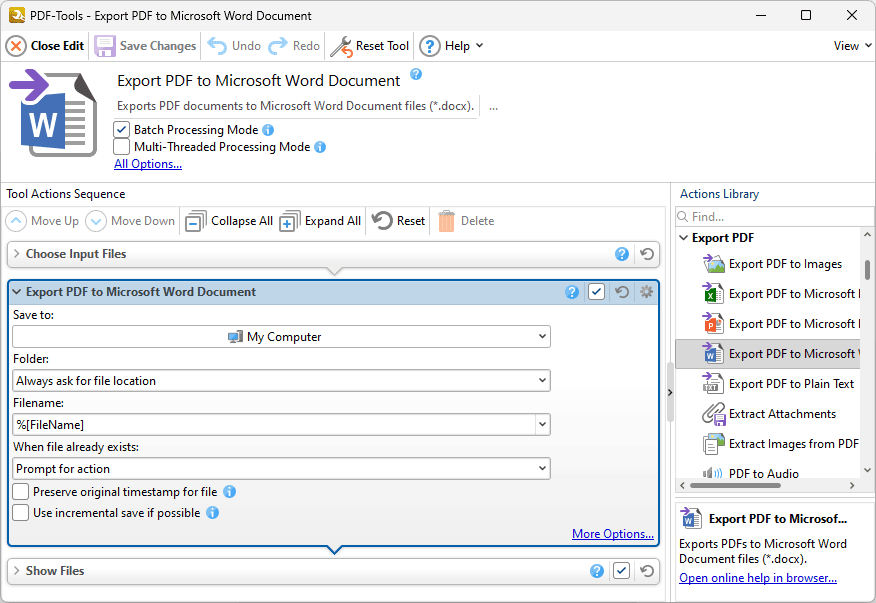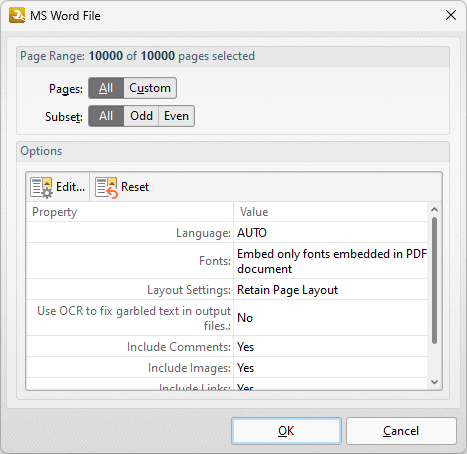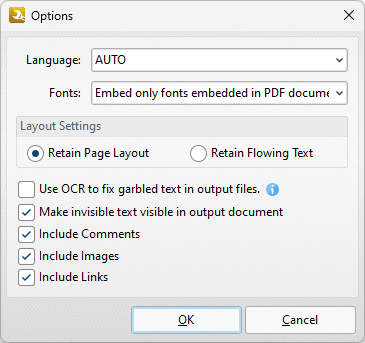 Export PDF to Microsoft Word Document
Export PDF to Microsoft Word Document
The Export PDF to Microsoft Powerpoint Word Document action copies PDF documents and converts them to Microsoft Word Document (*.docx) format. Files exported to (*.docx) format are compatible with MS Word 2010 and later. This action contains the following customizable parameters:

Figure 1. Export PDF to Microsoft Word Document Action Options
•Use the Save to dropdown menu to determine where output files are saved:
•Click My Computer to save files to the local computer.
•Hover over Add Place to add a new place at which to save files, then click Box.com, Dropbox, Google Drive, OneDrive or Sharepoint to add accounts from these locations. PDF-Tools will prompt for the login information for the selected account. When this information has been entered, the account will be detailed in the list and can be used to save files as desired.
•Use the Folder dropdown menu to determine where converted files are saved:
•Always ask for file location prompts the user to select a location each time the action is used.
•Use source folder as destination uses the source folder of input files as the save location.
•Use custom folder specified enables the user to specify a folder. If this option is used then the folder location must be specified in the text box beneath the dropdown menu.
•Use the Filename text box to name output files. The default name is defined by the macro %[Filename], which uses the name of the source file. Click the dropdown arrow to add additional macros.
•Use the When File Already Exists dropdown menu to determine the action taken when filenames are already in use:
•Prompt for action prompts the user for an action to take.
•Overwrite with a new file overwrites the existing file with the new file.
•Keep existing file unchanged retains the existing file and does not save the new file.
•Save new with other unique name inserts a prefix to the filename and then saves the new file.
•Click More Options for further options. The MS Word File dialog box will open:

Figure 2. MS Word File Dialog Box
The current settings for exporting files to MS Word format are detailed in the dialog box.
•Use the Page Range options to determine the page range from which to export pages to MS Word format. Further information on page range options is available here.
•Click Edit to edit export settings. The Options dialog box will open:

Figure 3. Options Dialog Box
•Use the Language dropdown menu to specify the language of the source document. This setting is necessary in cases where document text has the incorrect encoding and OCR is used to determine the correct unicode to use. AUTO is the default setting and the language is taken from the document properties when it is used.
•Use the Fonts dropdown menu to determine embedding options for fonts in output documents:
•Select Embed only fonts embedded in PDF document to embed the embedded fonts of source documents in output documents.
•Select No Embed to exclude font embedding in output documents.
•Use the Layout Settings to determine the layout setting for exported documents:
•Select either the Retain Page Layout or the Retain Flowing Text button as desired. Retain Page Layout adds a page break after each page and a line break to lines that are shorter than other lines within the same paragraph. Retain Flowing Text retains the text flow as a priority over the page layout and will allow text to wrap if there are multiple columns of text.
•Select the Make invisible text visible in output document to convert invisible text into visible text in output documents.
•Select/clear the Include Comments box to include/exclude comments in the conversion process.
•Select/clear the Include Images box to include/exclude images in the conversion process.
•Select/clear the Include Links box to include/exclude links in the conversion process.
Click OK to save changes.
Please note that MS Office must be installed on the local computer for this feature to operate, and Save As XPS functionality must be available in the version of MS Office being used. This functionality was added in MS Office 2007.